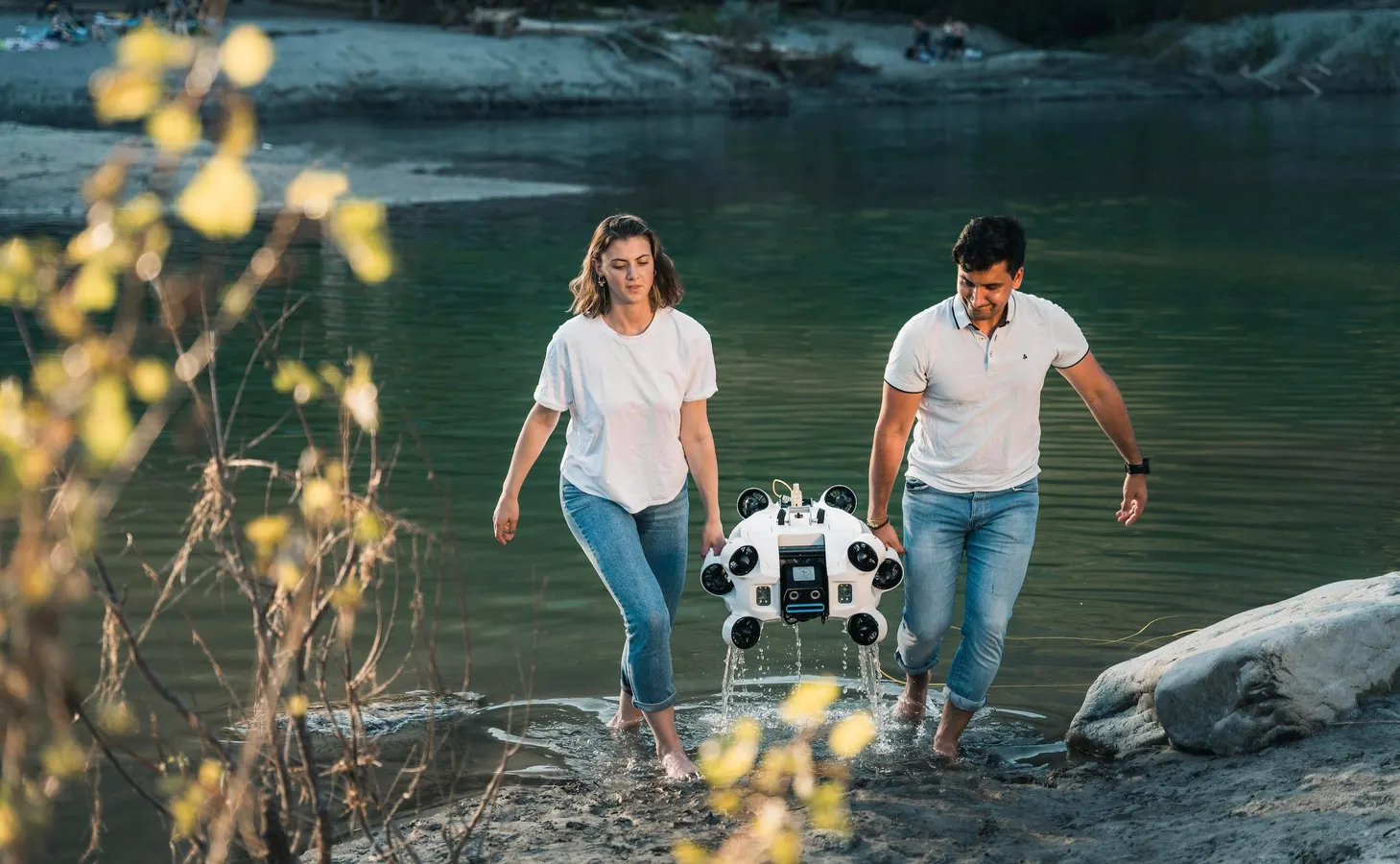Copyright forbes

A Tethy's underwater robot is being deployed Meet the Robots That Can See and Hear in the Dark Depths of the Ocean When Jonas Wüst first met rescue divers in Switzerland, what struck him wasn’t their courage, it was how much danger still defined their work. “We realized how outdated it all was,” he recalls. “Divers were still sent into low-visibility waters to inspect wrecks, recover objects, or deal with unexploded ordnance. It was slow, risky, and often guesswork.” That observation became the spark for Tethys Robotics, a Zurich-based spin-out from ETH Zurich university that’s now a catalyst in subsea automation disruption. The startup has just secured €3.5 million in pre-seed funding, led by Redstone with Euregio+ and Alpine VC, and backed by Zürcher Kantonalbank, the ETH Foundation, Kickfund, and Venture Kick. With new capital, the company plans to scale production, expand its autonomy and data teams, and transition from pilot projects to full commercial operations across Europe. “The goal is serial production and multi-unit contracts in offshore wind, oil & gas, and defence by 2026,” he adds. From University Labs to the Open Sea Wüst and his co-founders built their first prototypes while studying and conducting research at ETH Zurich, one of Europe’s most prestigious technical universities. “ETH gave us the playground,” he says. “We had access to labs, sensors, and the freedom to test ideas. What started as a side project quickly grew into a serious mission.” “In robotics, you’re always balancing speed and precision,” Wüst adds. “Move too slow and you lose momentum; move too fast and you break prototypes. We learned to iterate hard, build, test, learn, repeat.” MORE FOR YOU “The backbone of Swiss innovation really made this possible,” Wüst says: in an environment where deep-tech startups often struggle to reach commercialization, Switzerland’s innovation ecosystem including startup program’s Wyss Zurich and Innosuisse has been crucial to the startups growth. The turning point came when the team realized how far autonomy could go underwater; an environment where GPS doesn’t work and visibility is often near zero. They built a sensor-fusion stack that essentially mimics how marine animals perceive and navigate underwater, but in engineered form. Acoustic sensing mirrors how dolphins and whales use echolocation to “see” through sound. Magnetic and inertial sensing is similar to how certain fish and sea turtles use Earth’s magnetic fields and motion cues to orient themselves. Tethys underwater robots merge acoustic, magnetic, inertial, and visual data to localize and interpret surroundings in real time. “It’s what makes reliable autonomy possible below the surface,” Wüst explains. Its technology that has evolved - like marine animals - to have eyes and ears that work underwater. Tethys underwater robot Rethinking How Robots Work Underwater “Most underwater robots are either too bulky or too blind,” says Wüst. “They need big vessels, long setups, and skilled pilots. We wanted to make something that could be mobilized by two people, yet smart enough to work on its own.” The company’s first robot, Tethys ONE, weighs 35 kilograms, deploys in ten minutes, and dives to 300 meters. Despite its small size, it performs high-precision inspections, mapping, and detection tasks in conditions where visibility, temperature, and currents would defeat most existing systems. Operators can switch seamlessly between remote and self-guided modes, allowing the drone to plan routes, navigate, and collect data independently, while still giving humans full override when needed. Industry observers say this transition is already underway across offshore sectors. “The industry is undergoing a notable shift, as emerging technologies demonstrate consistent performance and build a solid track record particularly in less complex applications, which are steadily expanding,” says Richard van der Tuin, Offshore Business Development Manager at DWT. “Seabed survey operations, for example, are making significant strides toward full autonomy, while near-structure inspections are gaining momentum but face ongoing regulatory and technical challenges.” While companies like Exail in France and Vatn Systems in Norway are pushing the boundaries of underwater autonomy, many underwater robots remain anchored in narrow domains; primarily defence and security. Tethys, however, straddles both worlds: it’s compact enough for rapid civil deployment yet powerful enough for military-grade missions. The same system that can map corroding World War II munitions for defence clients can also inspect offshore wind turbines, monitor subsea infrastructure, or support environmental surveys. An engineer prepares to deploy an underwater robot Cleaning Up the Invisible World Beneath The need for safe, efficient underwater access has never been greater. Offshore wind farms require constant inspection, while one of the least recognized environmental hazards lies unseen: underwater munitions disposal. Across Europe, an estimated 1.3 million tons of explosive material from World War II remains submerged. As metal casings corrode, toxic compounds like TNT and RDX leach into marine sediments, threatening ecosystems and coastal communities. “Large areas aren’t even mapped,” says Wüst. “Our system can detect and classify munitions from a safe distance, produce 3D maps, and help prioritize what needs to be removed or monitored.” By replacing divers with autonomous units, the approach reduces human exposure and accelerates cleanup, a growing priority for governments and offshore operators. Van der Tuin agrees that cost and safety are the twin levers driving this transformation. “Current operations typically rely on a wide spread of a vessel, personnel, and equipment resulting in substantial capital expenditure,” he notes. “Advancements in robotics are dramatically reducing that footprint. They not only lower costs associated with data acquisition but also streamline the processing of sensor-derived data, paving the way for more economically viable and scalable deployment strategies.” The same capabilities appeal to offshore wind and oil & gas sectors, which need regular inspections of turbines, platforms, and subsea cables. According to a SkyTruth report, satellite and AI analysis found that twenty offshore oil and gas sites collectively leaked nearly 300,000 gallons of oil between June 2023 and October 2024; a reminder of why the sector urgently needs better inspection and prevention tools. After completing more than thirty pilot projects, Wüst says adoption is accelerating. “Customers are seeing vessel-time savings, faster mobilization, and data they can use directly for asset management.” Van der Tuin adds that these technologies could soon extend to renewable infrastructure and conservation work. “With the anticipated reduction in capital footprint, thanks to robotic and semi-autonomous advancements, operations are becoming significantly more efficient,” he explains. “Autonomous drones can pre-select areas of interest, allowing larger traditional ROVs to be deployed only where necessary. This hybrid approach optimizes both cost and operational effectiveness.” A team prepares to deploy an underwater Tethys robot The Next Frontier of Underwater Monitoring “Today we automate inspection and mapping,” says Wüst. “Tomorrow, we’ll automate decision-making, data analysis, even deployment from uncrewed surface vessels. No divers, no crewed ships, just digital workflows from shore.” That vision is already taking shape. As the link between climate and defence technology grows stronger, Tethys collaborates with the Swiss Army and the Swiss Drone and Robotics Centre (SDRC) on defence and disaster-response use cases including flooded areas and search-and-rescue missions in murky waters. “Anywhere people face danger underwater, autonomy can help locate, assess, and respond faster,” says Wüst. Van der Tuin believes full replacement of divers will still take time, but the direction is clear. “While we’re making significant strides toward reducing the need for human divers in hazardous underwater missions, complete replacement is still some distance away,” he says. “But equipment is now being engineered with robotic intervention in mind, minimizing the frequency of diver deployment by enabling remote or autonomous systems to handle routine and predictable tasks.” He adds that the barriers are as much cultural as technical. “Evolving standards and certification requirements still mandate human oversight in many jurisdictions, and the industry’s reliance on diver expertise will take time and proven reliability to shift toward autonomous solutions.” Environmental monitoring is another area of rising potential. Operating quietly and continuously, Tethys robot can observe habitats, track pollution, and monitor biodiversity without disturbing ecosystems, a capability that could redefine how conservationists gather long-term ocean data. This convergence between climate innovation and defence technology reflects a broader shift. “There’s a new generation of investors who no longer see sustainability and security as separate lanes,” says Ally LaTourelle Whitney, Founder of the Government Affairs Accelerator. “They’re thinking holistically, about how technology reduces conflict risk and resource dependence. This is fuelling support for what some call ‘peace tech.’” In ten years, Wüst envisions a world where every offshore energy or environmental-monitoring operation is handled by fleets of compact, autonomous drones communicating with uncrewed surface vessels “a future where the ocean economy runs safely, sustainably, and fully digital.” Underwater robotics are proving that the future of autonomy isn’t just about self-driving cars; it will revolutionize how humanity works with the sea. “Our job is to build systems that handle the danger, so people can handle the data,” says Wüst. Editorial StandardsReprints & Permissions



